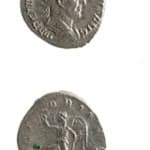Silver Antoninianus of Emperor Trajan Decius, 249 CE - 251 CE
Silver
C.4918
Obverse: IMP C M Q TRAIAN DECIVS AVG; Radiate and Draped Bust of the Emperor Facing Righ Reverse: VICTORIA AVG; Winged Victory Running to the Left, Holding a Wreath and...
Obverse: IMP C M Q TRAIAN DECIVS AVG; Radiate and Draped Bust of the Emperor Facing Righ
Reverse: VICTORIA AVG; Winged Victory Running to the Left, Holding a Wreath and a Palm Frond
Trajan Decius was proclaimed Emperor by the legions in July, A. D. 249 after having put down a rebellion of legions. Decius was popular with the soldiers because of this victory and later defeated the current Roman emperor Philip and his son, Philip II in battle near Verona in Italy. It was during the reign of Decius that the barbarian invasions began to dangerously threaten the empire. Decius was a very capable general and soundly defeated the Goths in battle. At first, the surprise attack on Roman army camp by Gothic King Cniva in 250 A. D. surprised him. Later, the Goths lured Decius and his army into a battle on swampy ground. The Roman soldier’s heavy armor caused them to sink into the mud; the Goths, however, were used to fighting on marshy ground and easily defeated the Romans. Trajan Decius and his son Herennius Etruscus were killed.
How many hands have touched a coin in your pocket or purse? What eras and lands have the coin traversed on its journey into our possession? As we reach into our pockets to pull out some change, we rarely hesitate to think of who might have touched the coin before us, or where the coin will venture to after it leaves our hands. More than money, coins are a symbol of the state that struck them, of a specific time and location, whether contemporary currencies or artifacts of a long forgotten empire. This stunning hand-struck coin reveals an expertise of craftsmanship and intricate sculptural detail that is often lacking in contemporary machine-made currencies. This coin is an artifact of an ancient leader passed from the hands of civilization to civilization, from generation to generation.
Reverse: VICTORIA AVG; Winged Victory Running to the Left, Holding a Wreath and a Palm Frond
Trajan Decius was proclaimed Emperor by the legions in July, A. D. 249 after having put down a rebellion of legions. Decius was popular with the soldiers because of this victory and later defeated the current Roman emperor Philip and his son, Philip II in battle near Verona in Italy. It was during the reign of Decius that the barbarian invasions began to dangerously threaten the empire. Decius was a very capable general and soundly defeated the Goths in battle. At first, the surprise attack on Roman army camp by Gothic King Cniva in 250 A. D. surprised him. Later, the Goths lured Decius and his army into a battle on swampy ground. The Roman soldier’s heavy armor caused them to sink into the mud; the Goths, however, were used to fighting on marshy ground and easily defeated the Romans. Trajan Decius and his son Herennius Etruscus were killed.
How many hands have touched a coin in your pocket or purse? What eras and lands have the coin traversed on its journey into our possession? As we reach into our pockets to pull out some change, we rarely hesitate to think of who might have touched the coin before us, or where the coin will venture to after it leaves our hands. More than money, coins are a symbol of the state that struck them, of a specific time and location, whether contemporary currencies or artifacts of a long forgotten empire. This stunning hand-struck coin reveals an expertise of craftsmanship and intricate sculptural detail that is often lacking in contemporary machine-made currencies. This coin is an artifact of an ancient leader passed from the hands of civilization to civilization, from generation to generation.



